Hydrostatics Transmission Of Fluid Pressure Pascal’s Law
If pressure is applied to a small region of a solid, then it is not transmitted throughout the entire volume. It only produces a local deformation in the solid. Since a fluid is not rigid like a solid, any similarly applied pressure is transmitted throughout the fluid.
A change in pressure at any point in a confined fluid produces an equal change in pressure at all points in the fluid. Pascal, a French scientist, determined the law of transmission of fluid pressure, which is known as Pascal’s law.
Pascal’s law: The pressure applied at any point of a confined fluid is transmitted with undiminished magnitude in all directions throughout the fluid and acts normally on the surface in contact with the fluid.
Read and Learn More: Class 11 Physics Notes
Demonstration of Pascal’s law
1. Take a rubber ball and fill it with water. Tie its mouth tightly. Take a pin and make fine holes at many points on its surface. If the ball is squeezed, it is seen that jets of water come out in the direction normal to the surface of the ball.
Observe carefully that the jets are all of the same speed and that this speed depends on the squeezing force applied. This shows that the applied pressure is transmitted equally in all directions throughout the liquid and acts normally at every point on the surface.
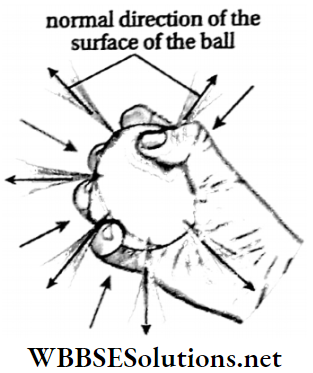
In the above demonstration, the effect of gravity has been ignored. This is justified only if the height h of the rubber ball is sufficiently small, so that the pressure hρg at its bottom is negligible compared to the pressure due to the externally applied squeeze.
2. A spherical vessel with four circular openings is taken. The holes A, B, C, D have cross-sectional areas a, b, c, and d respectively. Each opening is fitted with a piston. When a force is applied on a piston, it can move in or out The vessel is then filled with water or any other liquid. When an inward pressure is applied on any one of the pistons, it is seen that the other pistons move outwards.
This proves that pressure applied to any part of a confined fluid is transmitted in all directions. If one of the pistons is moved inwards, then to keep the other pistons at rest in their respective positions, an external force needs to be applied on each of them from outside.
If a force F1 is applied on the piston A, then the pressure applied on it = \(\frac{F_1}{a}\). To keep the pistons B, C, and D intact in their respective positions, forces F2, F3, and F4 respectively have to be applied. It is seen that
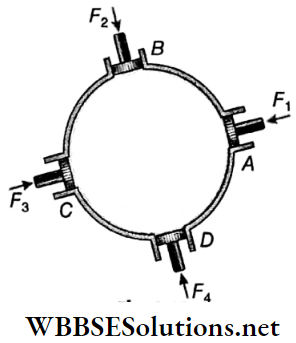
i.e., the pressure exerted on all the pistons is the same. It indicates that the pressure applied on the piston A is transmitted with undiminished magnitude in all directions throughout the fluid.
Principle of Multiplication of Thrust from Pascal’s Law: According to Pascal’s law, by applying a small force at any part of a confined liquid, a large force can be obtained at another part of it. This increase in the force is known as the principle of multiplication of thrust.
- A narrow and a wide cylinder are connected by a tube. Let the cross-sectional area of the narrow cylinder be a and that of the wider cylinder be b.
- The cylinders are filled with water and they are fitted with two water-tight frictionless pistons of negligible weights. The pistons have platforms for placing weights on their tops.
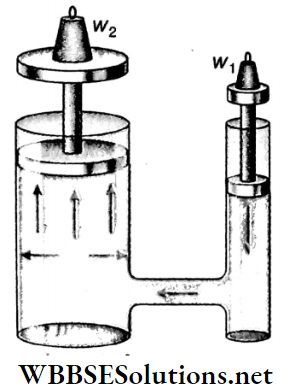
Now, a load w1 is placed on the smaller piston. So, the force applied on the smaller piston = w1
Therefore, the pressure exerted by the smaller piston on water = \(\frac{w_1}{a}\)
According to Pascal’s law, this pressure is transmitted invariably through water in all directions and it acts upwards on the larger piston.
So, the thrust or force exerted on the larger piston
= \(\text { pressure } \times \text { area }=\frac{w_1}{a} \times b\)
- So, a thrust that is n times the applied force will be effective on the larger piston. The larger the value of n, i.e., the larger the value of b compared to that of a, the heavier the weight w2 compared to wl.
- For example, if a = 1 cm2, b = 200 cm2 and w1 = 1 kg x g, then w2 = 200kg x g. So, by applying a force of 1 kg x g only on the smaller piston, a 200 kg x g force will be obtained on the larger piston.
- So, a small force acting at any part of a confined liquid can be multiplied at some other part of it. This is called the principle of the multiplication of thrust.
Conservation of energy in the case of multiplication of thrust: It may appear at first sight that the principle of the multiplication of thrust violates the principle of conservation of energy.
But, though we get a greater force on the large piston by applying a lesser force on the small piston, we cannot gain energy. Suppose a force wx on the smaller piston moves it downwards through a distance x. Consequently, the larger piston moves upwards through a distance y.
Since water is incompressible, the volume of water going out of the narrow cylinder = the volume of water added to the wider cylinder.
∴ ax = by or, \(\frac{x}{y}=\frac{b}{a}\)
Now, the work done on the smaller piston = \(w_1 \times x\) and the work done by the larger piston = \(w_2 \times y\).
But, \(w_2 y=w_1 \times \frac{b}{a} \times y=w_1 \times \frac{x}{y} \times y=w_1 x\)
∴ Work done by the larger piston = work done on the smaller piston,
i. e., the energy expended on the smaller piston can be recovered as the work done by the larger piston. So, the principle of conservation of energy is valid in this case. In the above example, the effect of friction is not considered.
In actual practice, however, some amount of energy is dissipated as heat in performing work against friction and therefore, work done by the larger piston < work done on the smaller piston.
It should be noted that as w2 >>w1, y << x and hence, the
displacement of the larger piston is much less than that of the smaller one.
- Hydraulic Press
- Hydraulic Brake
- Hydraulic Lift
Hydraulic press: The working of a hydraulic press is based on the principle of multiplication of thrust. The British engineer Bramah made some improvements on it and so these days it is also called Bramah’s press. In this machine, a large thrust can be developed.
Hydraulic press Description: A schematic diagram of a hydraulic press is shown in Fig It consists of two iron cylinders C1 and C2 connected by a tube T1.
- Two water-tight pistons P1 and P2 are fitted inside the cylinders. The cross-sectional area β of the larger piston P2 is much larger than the cross-sectional area α of the smaller piston P1. With the help of a lever OL, the piston P1 can be moved up and down the cylinder C1.
- A platform P is fitted at the upper end of the piston P2. The object B which is to be compressed is placed on this platform. The technical details of the apparatus has been omitted in our description.
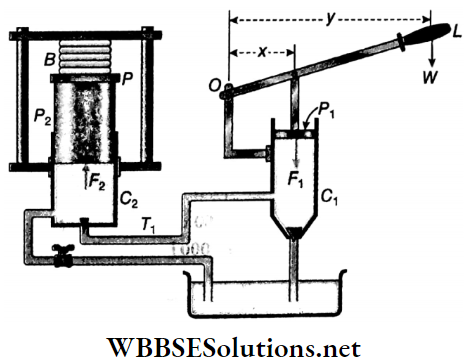
Hydraulic Press Action: The object which is to be compressed is placed on platform P. According to Pascal’s law, the pressure applied to the piston P1 with the help of the lever is transmitted to the larger piston P2.
Since the area of the cross-section of the piston P2 is much larger than that of the piston P1, a large thrust is exerted on the piston P2. As a result, the piston P2 moves upwards and any object placed between the platform P and the plate is compressed.
Hydraulic Press Total thrust developed: In this machine, thrust is multiplied in two stages. Initially, thrust is multiplied according to the principle of a lever and then it is multiplied again according to the principle of multiplication of thrust by Pascal’s law.
Let a force W be applied at the end of the lever which exerts a force F1 on the piston P1. Let the length of the longer arm of the lever = y and the length of the shorter arm = x.
∴ According to the principle of action of the lever
⇒ \(F_1 \cdot x=W \cdot y \quad \text { or, } F_1=W \cdot \frac{y}{x}\) ……(1)
α and β are the cross-sections of the smaller piston P1 and the larger piston P2 respectively. Therefore, the pressure exerted on water by the piston P1 = \(\frac{F_1}{a}\). According to Pascal’s principle, this pressure creates a thrust F2 on the piston P2.
∴ Thrust on the piston P2, \(F_2=\frac{F_1}{\alpha} \times \beta=W \cdot \frac{y}{x} \cdot \frac{\beta}{\alpha}\)…(2)
∴ \(y>x \text { and } \beta \gg \alpha,\)
⇒ \(F_2 \gg W\)
So, the thrust thus developed increases manifold.
Hydraulic Press Mechanical advantage: Mechanical advantage
= \(\frac{\text { thrust developed }}{\text { applied force }}=\frac{F_2}{W}=\frac{y}{x} \cdot \frac{\beta}{\alpha}\)
As y > x and β >>α,
the mechanical advantage is much greater than 1. It should be mentioned here that a part of the energy is dissipated due to friction and, so, the mechanical advantage becomes slightly less.
Hydraulic Press Uses: A hydraulic press is used for compressing bales of cotton, clothes, paper, or jute, in extracting oil from seeds, and for testing the strength of iron and steel beams.
The use of a hydraulic press is less common nowadays—it is still in use mainly in jute and similar industries.
Hydraulic brake: The principle is essentially that used in the construction of a hydraulic press. It uses a confined brake fluid, usually ethylene glycol, to transfer thrust from the controlling unit to the brake mechanism. The controlling unit is kept near the driver of a vehicle, whereas the actual brake mechanism is near the wheels of the vehicle. The controlling unit is also aided with a first-class lever system that offers a mechanical advantage.
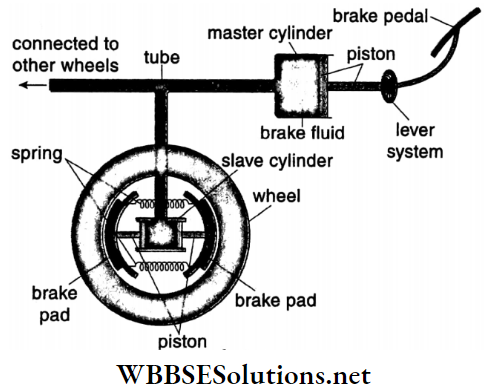
Hydraulic Brake Action: A hydraulic brake uses two cylinders for the multiplication of thrust. The area of the piston attached to the slave cylinder near the wheels is usually four to six times that of the piston in the master cylinder iff control of the driver. The mechanical advantage of the lever is about 3.
- So, to produce a 1cm displacement of the slave piston, the driver has to push down the lever by about 15 cm. The movement of the slave piston then applies a force on the brake pads, which in turn push against the rotating wheel. The friction between the pads and the wheels generates a braking torque that slows down the vehicle.
- A series of springs are set in the system so that, as soon as the driver releases the lever, the brake pads release the wheels.
Some important points to be noted:
- Hydraulic brakes are smaller and cheaper than air or vacuum brakes.
- The brake fluid must be incompressible so that a high multiplication of thrust is obtained from a single stroke of the master lever—in this sense, the operation is easy.
- Water vaporizes easily due to the heat produced from friction inside the system, and also produces corrosion of the metal parts. So water is never used as the brake fluid—light organic oils are more common.
Hydraulic lift: At present times, the use of the device as a hydraulic lift is very common. For example, an automobile workshop uses it to lift motor cars and heavier vehicles for their maintenance and repair.
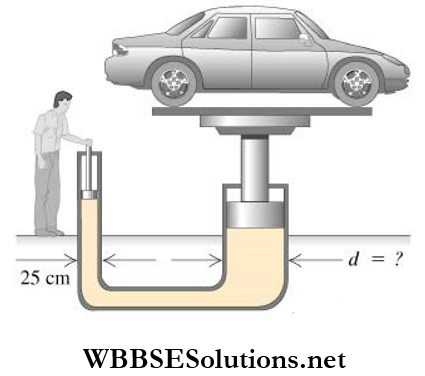
Hydraulic lift Working principle: Let the area of cross-sections of the smaller piston be A1 and of the larger piston be A2(A2>>A1) . If the applied force on the smaller piston is F, then the pressure on the liquid is p = \(\frac{F_1}{A_1}\)
According to Pascal’s law, this pressure is transferred to the larger piston with its value unchanged and F2 thrust is generated.
So the thrust on the larger piston,
F2 = p x A2 = (F1/A1) X A2
A2>> A1 and so F2 >> F1.
So, if some heavy object or car is placed on the larger piston, it can be lifted easily by the increased thrust F2. Normally the plate on the larger piston is kept at the ground level.
Hydrostatics Transmission Of Fluid Pressure Pascal’s Law Numerical Examples
Example 1. In a hydraulic press, a 107 dyn force is applied on water by a piston of area 100 cm2. If the other piston can raise a car of mass 2000 kg, then find Its base area.
Solution:
In a hydraulic press, a 107 dyn force is applied on water by a piston of area 100 cm2. If the other piston can raise a car of mass 2000 kg
We know that, \(\frac{F_1}{\alpha}=\frac{F_2}{\beta}\)
Here, F1 = 107 dyn, a = 100 cm2,
F2 = 2000 kg x g = 2000 x .1000 x 980 dyn.
∴ \(\beta=\frac{F_2 \alpha}{F_1}=\frac{2000 \times 1000 \times 980 \times 100}{10^7}=19600 \mathrm{~cm}^2 .\)
Example 2. The diameters of the two pistons of a hydraulic press are 0.1 m and 1 m. The lengths of the two arms of a first-class lever are 0.15 m and 0.9 m. A 50 N force is applied at the end of the lever. Determine the total thrust developed on the larger piston.
Solution:
The diameters of the two pistons of a hydraulic press are 0.1 m and 1 m. The lengths of the two arms of a first-class lever are 0.15 m and 0.9 m. A 50 N force is applied at the end of the lever.
We know that the thrust developed on the larger piston,
⇒ \(F_2=W \cdot \frac{y}{x} \cdot \frac{\beta}{\alpha}\)
Here, force applied at the end of the lever arm, W = 50 N
Area of the larger piston, β = π(0.5)2 = 0.25π m2
Area of the smaller piston, α = π(0.05)2 = 0.0025π m2
Length of the longer arm of the lever, y = 0.9 m
Length of the smaller arm of the lever, x = 0.15 m
∴ \(F_2=50 \times \frac{0.9}{0.15} \times \frac{0.25 \pi}{0.0025 \pi}=3 \times 10^4 \mathrm{~N} .\)
Example 3. A bottle completely filled with water is corked. The areas of the mouth and the bottom of the bottle are 10 cm2 and 100 cm2 respectively and the height of the bottle is 40 cm. If the cork is pressed with a 10 N force, then calculate the total thrust on its bottom.
Solution:
A bottle completely filled with water is corked. The areas of the mouth and the bottom of the bottle are 10 cm2 and 100 cm2 respectively and the height of the bottle is 40 cm. If the cork is pressed with a 10 N force
Area of a cross-section of the cork = 10 cm2; area of the bottom of the bottle = 100 cm2.
Pressure on the cork = 1 N · cm-2.
According to Pascal’s law, the pressure exerted on the bottom of the bottle, p = 1N · cm-2.
∴ Thrust on the bottom of the bottle due to the applied pressure, F1 =1 x 100 = 100 N
Thrust on the bottom of the bottle due to the water in it, F2 = hρgxA
Here, h = 40cm = 0.4m, ρ = 103kg · m-3, g = 9.8m · s-2,
A = 100cm2 = 10-2m2
∴ F2 = 0.4 x 103 x 9.8 x 10-2 = 39.2 N
∴ Total thrust on the bottom = F1 + F2 = 100 + 39.2 = 139.2N
Example 4. A hydraulic automobile lift is used to lift a car of mass 3000 kg. The cross-sectional area of the piston on which the car is supported is 425 cm2. What pressure would the smaller piston have to bear if the bigger piston with the car is 3 m above the smaller piston? The density of the oil filling the hydraulic machine is 800 kg · m-3. Let the pistons be of equal mass.
Solution:
A hydraulic automobile lift is used to lift a car of mass 3000 kg. The cross-sectional area of the piston on which the car is supported is 425 cm2.
The positions of the pistons (with a car) of a hydraulic automobile lift is shown in Fig.
Let the area of the larger piston = A2 and the area of the smaller piston = A1
If the pressure applied on the smaller piston is p1, then according to Pascal’s law,
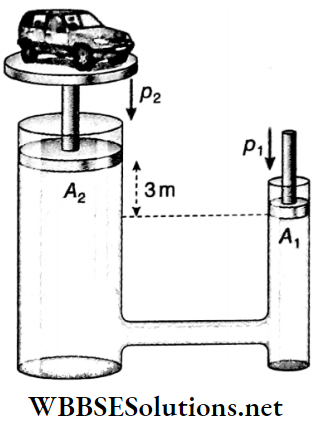
p1 = pressure on the larger piston + pressure exerted by a 3m liquid column
= \(\frac{W}{A_2}\) + pressure exerted by a 3 m liquid column A2 [W = weight of the car]
= \(\frac{3000 \times 9.8}{425 \times 10^{-4}}+3 \times 800 \times 9.8=7.155 \times 10^5 \mathrm{~N} \cdot \mathrm{m}^{-2}\)
Example 5. The diameters of the larger and the smaller pistons of a hydraulic press are 45 cm and 5 cm respectively. Find the magnitude of the force that has to be applied on the smaller piston to produce a 4050N thrust on the larger piston.
Solution:
The diameters of the larger and the smaller pistons of a hydraulic press are 45 cm and 5 cm respectively.
According to Pascal’s law, \(\frac{F_1}{\pi r_1^2}=\frac{F_2}{\pi r_2^2}\)
[F1 = force on the smaller piston, r1 = radius of the smaller piston, F2 = force on the larger piston, r2 = radius of the larger piston]
∴ \(\frac{F_1}{r_1^2}=\frac{F_2}{r_2^2} \text { or, } \frac{F_1}{\left(\frac{5}{2}\right)^2}=\frac{4050}{\left(\frac{45}{2}\right)^2}\)
or, \(F_1=\frac{4050 \times 25 \times 4}{4 \times 45 \times 45}=50 \mathrm{~N}\)

